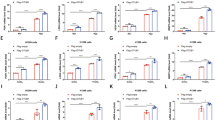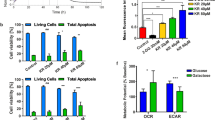Abstract
Induction of HIF-1α by oxygen limitation promotes increased phosphorylation and catalytic depression of mitochondrial pyruvate dehydrogenase (PDH) and an enhanced glycolytic poise in cells. Cobalt chloride and desferrioxamine are widely used as mimics for hypoxia because they increase the levels of HIF-1α. We evaluated the ability of these agents to elicit selected physiological responses to hypoxia as a means to metabolically precondition mammalian cells, but without the detrimental effects of hypoxia. We show that, while CoCl2 does increase HIF-1α in a dose-dependent manner, it unexpectedly and strikingly decreases PDH phosphorylation at E1α sites 1, 2, and 3 (Ser293, Ser300, and Ser232, respectively) in HepG2 cells. This same effect is also observed for site 1 in mouse NIH/3T3 fibroblasts and J774 macrophages. CoCl2 unexpectedly decreases the mRNA expression for PDH kinase-2 in HepG2 cells, which likely explains the dephosphorylation of PDH observed. And nor does desferrioxamine promote the expected increase in PDH phosphorylation. Dimethyloxaloylglycine (a prolyl hydroxylase inhibitor) performs better in this regard, but failed to promote the stronger effects seen with hypoxia. Consequently, CoCl2 and desferrioxamine are unreliable mimics of hypoxia for physiological events downstream of HIF-1α stabilization. Our study demonstrates that mimetic chemicals must be chosen with caution and evaluated thoroughly if bona fide cellular outcomes are to be promoted with fidelity.






Similar content being viewed by others
References
Alchera E, Dal Ponte C, Imarisio C, Albano E, Carini R (2010) Molecular mechanisms of liver preconditioning. World J Gastroenterol 16:6058–6067
Bowker-Kinley MM, Davis WI, Wu P, Harris RA, Popov KM (1998) Evidence for existence of tissue-specific regulation of the mammalian pyruvate dehydrogenase complex. Biochem J 329:191–196
Brunelle JK, Bell EL, Quesada NM, Vercauteren K, Tiranti V, Zeviani M, Scarpulla RC, Chandel NS (2005) Oxygen sensing requires mitochondrial ROS but not oxidative phosphorylation. Cell Metab 1:409–414
Bunn HF, Poyton RO (1996) Oxygen sensing and molecular adaptation to hypoxia. Physiol Rev 76:839–885
Eckle T, Hartmann K, Bonney S, Reithel S, Mittelbronn M, Walker LA, Lowes BD, Han J, Borchers CH, Buttrick PM, Kominsky DJ, Colgan SP, Eltzschig HK (2012) Adora2b-elicited per2 stabilization promotes a HIF-dependent metabolic switch crucial for myocardial adaptation to ischemia. Nat Med 18:774–782
Gohil VM, Sheth SA, Nilsson R, Wojtovich AP, Lee JH, Perocchi F, Chen W, Clish CB, Ayata C, Brookes PS, Mootha VK (2010) Nutrient-sensitized screening for drugs that shift energy metabolism from mitochondrial respiration to glycolysis. Nat Biotechnol 28:249–255
Gohil VM, Offner N, Walker JA, Sheth SA, Fossale E, Gusella JF, MacDonald ME, Neri C, Mootha VK (2011) Meclizine is neuroprotective in models of Huntington’s disease. Hum Mol Genet 20:294–300
Goldberg MA, Glass GA, Cunningham JM, Bunn HF (1987) The regulated expression of erythropoietin by two human hepatoma cell lines. Proc Natl Acad Sci USA 84:7972–7976
Goldberg M, Dunning S, Bunn H (1988) Regulation of the erythropoietin gene: evidence that the oxygen sensor is a heme protein. Science 242:1412–1415
Goldwasser E, Jacobson LO, Fried W, Plzak LF (1958) Studies on erythropoiesis: V. The effect of cobalt on the production of erythropoietin. Blood 13:55–60
Guzy RD, Hoyos B, Robin E, Chen H, Liu L, Mansfield KD, Simon MC, Hammerling U, Schumacker PT (2005) Mitochondrial complex III is required for hypoxia-induced ROS production and cellular oxygen sensing. Cell Metab 1:401–408
Halestrap AP (2010) A pore way to die: the role of mitochondria in reperfusion injury and cardioprotection. Biochem Soc Trans 38:841–860
Hand SC, Menze MA, Borcar A, Patil Y, Covi JA, Reynolds JA, Toner M (2011a) Metabolic restructuring during energy-limited states: insights from Artemia franciscana embryos and other animals. J Insect Physiol 57:584–594
Hand SC, Menze MA, Toner M, Boswell L, Moore D (2011b) LEA proteins during water stress: not just for plants anymore. Annu Rev Physiol 73:115–134
Harris RA, Bowker-Kinley MM, Huang B, Wu P (2002) Regulation of the activity of the pyruvate dehydrogenase complex. Adv Enzym Regul 42:249–259
Hyvärinen J, Hassinen IE, Sormunen R, Mäki JM, Kivirikko KI, Koivunen P, Myllyharju J (2010) Hearts of hypoxia-inducible factor prolyl 4-hydroxylase-2 hypomorphic mice show protection against acute ischemia-reperfusion injury. J Biol Chem 285:13646–13657
Ivan M, Kondo K, Yang H, Kim W, Valiando J, Ohh M, Salic A, Asara JM, Lane WS, Kaelin WG Jr (2001) HIFα targeted for VHL-mediated destruction by proline hydroxylation: Implications for O2 sensing. Science 292:464–468
Jaakkola P, Mole DR, Tian Y-M, Wilson MI, Gielbert J, Gaskell SJ, Av K, Hebestreit HF, Mukherji M, Schofield CJ, Maxwell PH, Pugh CW, Ratcliffe PJ (2001) Targeting of HIF-α to the von Hippel-Lindau ubiquitylation complex by O2-regulated prolyl hydroxylation. Science 292:468–472
Ježek P, Plecitá-Hlavatá L, Smolková K, Rossignol R (2010) Distinctions and similarities of cell bioenergetics and the role of mitochondria in hypoxia, cancer, and embryonic development. Int J Biochem Cell Biol 42:604–622
Jiang BH, Semenza GL, Bauer C, Marti HH (1996) Hypoxia-inducible factor 1 levels vary exponentially over a physiologically relevant range of O2 tension. Am J Physiol 271:C1172–C1180
Jose C, Bellance N, Rossignol R (2011) Choosing between glycolysis and oxidative phosphorylation: a tumor’s dilemma? Biochim Biophys Acta 1807:552–561
Kaelin WG, Ratcliffe PJ (2008) Oxygen sensing by metazoans: the central role of the HIF hydroxylase pathway. Mol Cell 30:393–402
Kim J-W, Tchernyshyov I, Semenza GL, Dang CV (2006) HIF-1-mediated expression of pyruvate dehydrogenase kinase: a metabolic switch required for cellular adaptation to hypoxia. Cell Metab 3:177–185
Korotchkina LG, Patel MS (2001) Site specificity of four pyruvate dehydrogenase kinase isoenzymes toward the three phosphorylation sites of human pyruvate dehydrogenase. J Biol Chem 276:37223–37229
Lu C-W, Lin S-C, Chen K-F, Lai Y-Y, Tsai S-J (2008) Induction of pyruvate dehydrogenase kinase-3 by hypoxia-inducible factor-1 promotes metabolic switch and drug resistance. J Biol Chem 283:28106–28114
Menze MA, Clavenna MJ, Hand SC (2005) Depression of cell metabolism and proliferation by membrane-permeable and -impermeable modulators: role for AMP-to-ATP ratio. Am J Physiol Regul Integr Comp Physiol 288:R501–R510
Menze MA, Chakraborty N, Clavenna M, Banerjee M, Liu X-H, Toner M, Hand SC (2010) Metabolic preconditioning of cells with AICAR-riboside: improved cryopreservation and cell-type specific impacts on energetics and proliferation. Cryobiology 61:79–88
Papandreou I, Cairns RA, Fontana L, Lim AL, Denko NC (2006) HIF-1 mediates adaptation to hypoxia by actively downregulating mitochondrial oxygen consumption. Cell Metab 3:187–197
Pfaffl MW (2001) A new mathematical model for relative quantification in real-time RT–PCR. Nucleic Acids Res 29:2002–2007
Pugh CW, O’Rourke JF, Nagao M, Gleadle JM, Ratcliffe PJ (1997) Activation of hypoxia-inducible factor-1; definition of regulatory domains within the α subunit. J Biol Chem 272:11205–11214
Sarkar K, Cai Z, Gupta R, Parajuli N, Fox-Talbot K, Darshan MS, Gonzalez FJ, Semenza GL (2012) Hypoxia-inducible factor 1 transcriptional activity in endothelial cells is required for acute phase cardioprotection induced by ischemic preconditioning. Proc Natl Acad Sci USA 109:10504–10509
Semenza GL (2007) Oxygen-dependent regulation of mitochondrial respiration by hypoxia-inducible factor 1. Biochem J 405:1–9
Semenza GL (2010) HIF-1: upstream and downstream of cancer metabolism. Curr Opin Genet Dev 20:51–56
Semenza GL (2011) Hypoxia-inducible factor 1: regulator of mitochondrial metabolism and mediator of ischemic preconditioning. Biochim Biophys Acta 1813:1263–1268
Semenza GL, Wang GL (1992) A nuclear factor induced by hypoxia via de novo protein synthesis binds to the human erythropoietin gene enhancer at a site required for transcriptional activation. Mol Cell Biol 12:5447–5454
Vander Heiden MG, Cantley LC, Thompson CB (2009) Understanding the Warburg effect: the metabolic requirements of cell proliferation. Science 324:1029–1033
Wang G, Semenza G (1993a) Desferrioxamine induces erythropoietin gene expression and hypoxia-inducible factor 1 DNA-binding activity: implications for models of hypoxia signal transduction. Blood 82:3610–3615
Wang GL, Semenza GL (1993b) General involvement of hypoxia-inducible factor 1 in transcriptional response to hypoxia. Proc Natl Acad Sci USA 90:4304–4308
Acknowledgments
The authors would like to thank Benjamin Adams from the Department of Entomology at Louisiana State University for his help in performing statistical analyses.
Author information
Authors and Affiliations
Corresponding author
Additional information
This study was supported by National Institutes of Health (2-RO1-DK046270-14A1)
Rights and permissions
About this article
Cite this article
Borcar, A., Menze, M.A., Toner, M. et al. Metabolic preconditioning of mammalian cells: mimetic agents for hypoxia lack fidelity in promoting phosphorylation of pyruvate dehydrogenase. Cell Tissue Res 351, 99–106 (2013). https://doi.org/10.1007/s00441-012-1517-2
Received:
Accepted:
Published:
Issue Date:
DOI: https://doi.org/10.1007/s00441-012-1517-2




